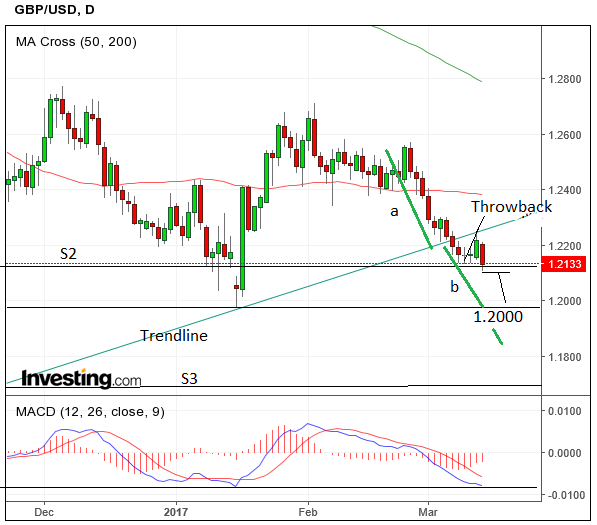British GBP/USD Rate Catches a Bid as 2nd Scottish Independence Referendum put in Doubt

The Pound to Dollar exchange rate (GBP/USD) traded higher on news reports that Nicola Sturgeon, Scotland's first minister, may have to drop her plan for automatically keeping Scotland in the EU if it wins independence in a second Scottish referendum.
At the time of writing the exchange rate is quoted at 1.2211, having hit a daily best at 1.2258.
Sources close to Sturgeon reported that she was thinking of climbing down from plans to automatically keep Scotland in the EU assuming a referendum win for independence.
Polls also show that the majority of Scots want Europe's powers reduced, something that has thrown Sturgeon's bid to hold a referendum keeping Scotland in the EU and have forced her to consider seperating the two issues.
Indeed, one poll suggests that Euroscepticism in Scotland has hit record highs.
The most recent YouGov poll on the matter showing 43% would vote for independence while 57% would vote to remain part of the UK.
This is the highest No lead since August 2014 when the referendum campaign was in full swing.
"Cable verticalized nearly 100 points in a matter of minutes on news that Scottish First Minister Nicola Sturgeon would have a difficult time calling another independence referendum. This is the highest No lead since August 2014 when the referendum campaign was in full swing," says Boris Schlossberg, Director at BK Asset Management in New York.
On Monday, Sturgeon made a strong appeal for another referendum vote in the wake of UK pulling out of EU, angering Whitehall, "but despite the fact that Scotland voted to remain in EU the general will of the populace appears to resist the idea of going into the union alone away from the membership within the UK," notes Schlossberg.
Employment Data Strong; Wages Not
Mixed Jobs data could not have contributed to Sterling's advance on Wednesday morning, as although it showed a welcome fall in the Unemployment Rate to 4.7% from 4.8% previously, average wages slipped to 2.2% from 2.6% previously and below analysts estimates of 2.4%.
One strong positive from the data was a deeper than expected -11.3k fall in February - much lower than the -5k forecast by economists.
Recovery in Pound Unlikely to Endure
Analysts see the current rise in GBP/USD as nothing more than technical in nature as traders squared up on trades to take profit amidst the ongoing uncertainty concerning the UK's future.
"With a Federal Reserve rate hike on the horizon (and the prospect of held rates from the Bank of England on Thursday), calls for a second Scottish independence referendum and a fast approaching Article 50 trigger date, there isn’t a lot going Sterling’s way at the moment. GBP/USD is sitting firmly at 8 week lows after plunging 0.8%, while against the euro the pound has shed 0.6%," says analyst Connor Campbell at Spreadex in London.
The big question now is can the pair go any lower or will it continue to find buying interest at historical lows?
Last week GBP/USD pierced the trendline drawn from the October 2016 lows but then failed to follow-through to the downside, pulling back up instead, in what is called a ‘throwback’, back up to overhead resistance from the just-pierced major trendline.

The exchange rate then, metaphorically, ‘air-kissed’ the trend-line goodbye before moving lower once again during bearish activity today (Tuesday).
The move below the previous 1.2134 lows is a strong signal that the short-term downtrend is beginning a fresh leg lower.
What is impeding bears from pushing the exchange rate lower at the moment, however, is the obstacle of the S2 monthly pivot at 1.2118.
This a major obstacle for the downtrend to overcome as professional traders often us the pivot as a starting point to make trades counter to the trend, which means there is likely a lot of buying activity around that level.
Eventually we expect a continuation lower – not just for technical reasons – but also fundamental reasons.
From a technical perspective, the move after the trendline break looks incomplete and so we would expect more downside.
In the vast majority of breaks the move after the trendline is usually the same length as the move immediately prior to the break.
These are illustrated using green lines on the chart above. The move prior is annotated ‘a’ and the move after ‘b’; essentially ‘b’ should equal ‘a’, which means the pair could go down to the 1.19s.
Fundamental Reasons for Expecting GBP/USD to Weaken
The bearish fundamental factors in favour of more downside are also persuasive.
Interest rates are likely to go up in America on Wednesday after the March meeting of the Federal Reserve, and this should support the Dollar.
Higher relative interest rates support currencies as they attract more foreign capital inflows seeking a better return on their money.
Whilst this eventuality has arguably already been priced into the Dollar analysts will also be tracking the individual views of Fed members, and if more have joined the consensus that there should be two further rate rises in 2017 this may add some further upside impetus to the Dollar.
Likewise, if the consensus has shifted to expecting three more rate rises in 2017 – for a total of four – the Dollar will definitely rise.
Given the positive data out of the US recently there is a chance now of members expecting four rises.
Bank of England on Hold
The Bank of England has their rate meeting on Thursday, the day after the Fed and this could further impact on GBP/USD.
The BOE is not forecast to change rates at the meeting, but the minutes, released at the same time, will provide a valuable insight into the BOE’s current thinking on future policy.
Not long ago some commentators were discussing the possibility of rate rise and seeing BOE’s Kirsten Forbes as the possible protagonist of a hawkish ‘mutiny’, however, we do not foresee this happening at Thursday’s meeting.
The relatively prudent Spring budget has reduced the chances of the BOE raising interest rates.
With no real fiscal stimulus going into the economy at a time of great political uncertainty the BOE will probably see the most stable path as that of keeping monetary policy loose and therefore interest rates low.
Keeping interest rates lower for longer will impact negatively on Sterling and see a probable discounting of GBP/USD.
But Isn't the Pound Grossly Undervalued?
Those who question the bearish case for the Pound point to the fact that according to fair value models, which are used by financial institutions to estimate the ‘true’ or fair value of a currency, and involve complex models that calculate this based on known variables and fundamentals, the Pound is actually currently far lower than it ‘should’ be.
SEB Bank’s Chief Currency Strategist, Richard Falkenhall, for example, notes how the Pound is undervalued by over 20% versus other major currencies.
“From a long-term perspective, the GBP is substantially undervalued against most currencies. Our own long-term fair value estimate suggests it is around 20% undervalued against the euro and more than 25% undervalued against the dollar,” said the strategist in a note seen by Pound Sterling Live.
Yet even so, in a telling sign, Falkenhall goes on to advocate a bearish stance on the Pound, expecting it to fall even further.
This is because political risks are hard quantify and the fair value models used by analysts often do not incorporate them in their estimates, as such, one of the most significant weights on Sterling from the political uncertainty caused by Brexit explains the undervaluation, and remains a depressing factor going forward.
“With UK Prime Minister Theresa May set to trigger Article 50 as a prelude to two years of likely tough divorce negotiations with the EU, Sterling faces renewed pressure from markets. Further concerns have probably been exacerbated by proposals from the Scottish First Minister Nicola Sturgeon to set a date for a second referendum on Scottish independence,” says Falkenhall.
The strategist expects a “harsh tone” to dominate up-and-coming divorce negotiations and for this to pressure the Pound.
“A shift to political risks elsewhere could offer some temporary relief, but this should be seen as an opportunity to sell the GBP,” says Falkenhall.
These factors lead Falkenhall to make an outright bearish call on the Pound over the next few months:
“Our main scenario in the coming months is that downward pressure on the GBP will persist, mostly due to concerns related to Brexit talks and weaker than expected UK growth."
Whilst he sees the possibility of temporary respite for the market, this is unlikely to last.
“One alternative scenario is that the sterling recovers temporarily just because the ‘one-eyed’ market could refocus on some other issue like political risks elsewhere, as it did in February. Nevertheless, such a development is unlikely to be long-lasting,” added the strategist.
Falkenhall argues the fact Sterling is undervalued is no insurance against further losses – indeed research shows currencies can remain under or overvalued according to fair value estimates for long periods of time.
“The fact that the GBP now appears cheap is insufficient to sustain a credible recovery by the currency at this stage. We recommend selling sterling on any temporary rally triggered by a shift in market focus. We maintain our target for EUR/GBP close to 0.90 and GBP/USD well below 1.20 in Q3,” concludes Falkenhall.





